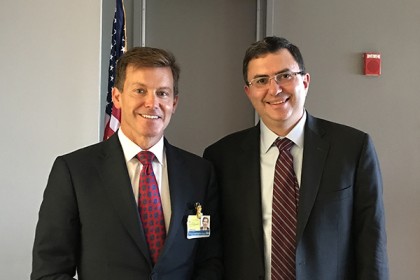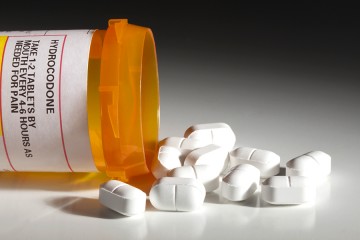Peter Pronovost is the doctor who led Johns Hopkins to redefine the way the hospital prevents catheter infections. The approach was so successful that it has been implemented in hospitals across the country and has helped reduce the rates of these deadly infections by 80 percent.
Now Pronovost has some big ideas about preventing opioid abuse in the U.S.

Image caption: Peter Pronovost (left) and Josh Sharfstein
"We have a really, really big problem before us," he said during his morning keynote address at the Johns Hopkins Pain Symposium, which was held today at The Johns Hopkins Hospital.
Pronovost, who leads the Armstrong Institute for Patient Safety and Quality, explained the challenge faced by health professionals and policymakers.
In the U.S., about 1,000 people a day are treated in emergency rooms for complications from narcotics, he said. He added that in 2015, one-third of all Americans had a prescription for a narcotic, and between 6 and 8 percent of surgical patients continue using narcotics for pain six months after their surgeries. More than half of all people who abuse narcotics got the drugs from a family member or a friend, and three-quarters of people who misuse opiates started with a prescription opiate.
Also see
What's more, added Pronovost, opioids might not have to be prescribed in the first place—only 5 percent of people who are prescribed opiates have maximized non-narcotic pathways to pain management. He challenged symposium attendees to consider new ways of framing the narrative about the opioid epidemic.
"We still view harm as something that's inevitable rather than preventable," he said. "... We have to declare, and we will declare, a goal of ending harm from opiates abuse. The key is defining the behaviors that you want to change, finding the barriers to implementing those behaviors, and making sure we design systems to ensure the behaviors are always practiced."
Some of the key behaviors Pronovost said will contribute to preventing opioid abuse in the U.S. include:
- Only prescribing narcotics to people who actually need them
- Maximizing non-narcotic therapies for pain management
- Minimizing the number of pills prescribed
- Ensuring the safe disposal of excess pills in a way that is clear and convenient for patients
- Engaging clinicians in best practices training
Joshua Sharfstein, associate dean of public health practice and training at the Johns Hopkins Bloomberg School of Public Health, shared his views on addressing the opioid epidemic from the public health perspective.
He discouraged thinking of the crisis as either a pain management problem or a drug abuse problem, saying that approaches to ending the public health crisis that only address one or the other are likely to fail.
"Public health isn't just about the end, it's about a mechanism to get there and a way of thinking," he said. "You can't say, 'All we care about are the overdoses from opioids, we don't care at all about how much pain people are in.' You have to do both at the same time. And this is particularly important because the risks of untreated pain and the risks of addiction with treatment coexist in the same people. It's not one group of people you're worried about for pain and another group you're worried about for addiction—you have to deal with both."
Other speakers at today's symposium included:
- Caleb Alexander, co-director of the Center for Drug Safety and Effectiveness at the Bloomberg School
- Mark Bicket, director of the Pain Fellowship Program in the Department of Anesthesiology and Critical Care Medicine
- Maryland Lt. Gov. Boyd Rutherford










